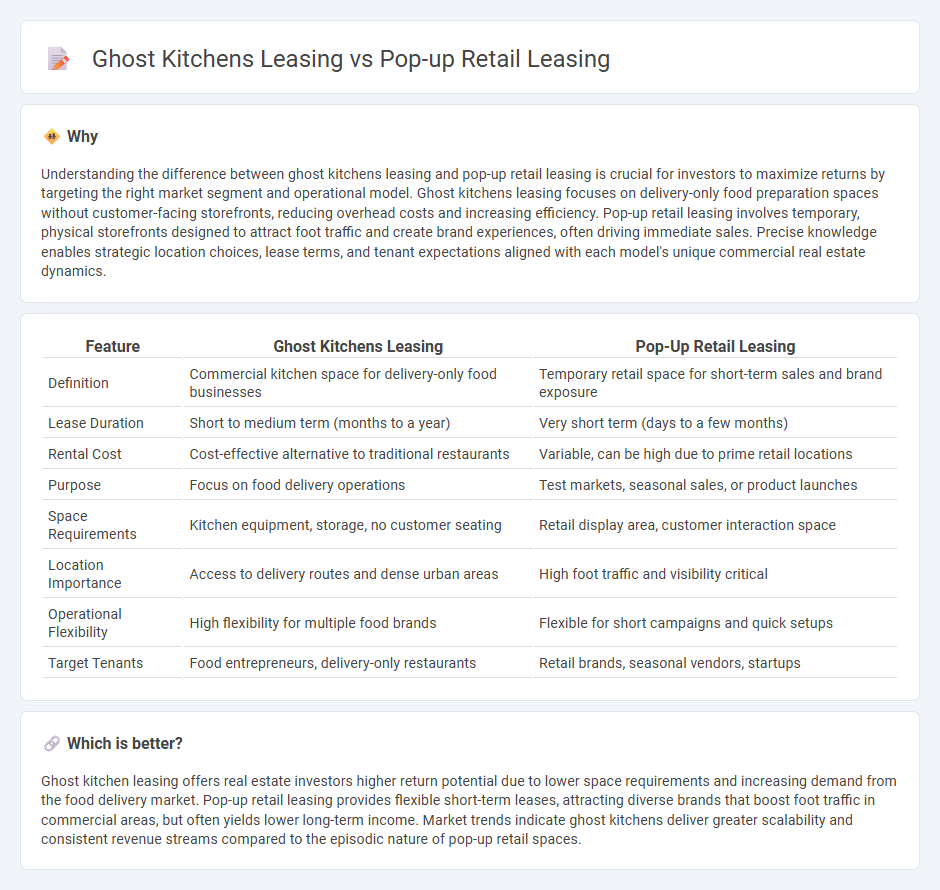
Ghost kitchens leasing offers a cost-effective solution for food entrepreneurs by providing flexible, delivery-focused kitchen spaces without the overhead of traditional restaurants. Pop-up retail leasing enables brands to create temporary physical storefronts, driving direct consumer engagement and testing market demand with lower long-term commitments. Explore the benefits and strategic differences between these leasing models to optimize your real estate investments.
Why it is important
Understanding the difference between ghost kitchens leasing and pop-up retail leasing is crucial for investors to maximize returns by targeting the right market segment and operational model. Ghost kitchens leasing focuses on delivery-only food preparation spaces without customer-facing storefronts, reducing overhead costs and increasing efficiency. Pop-up retail leasing involves temporary, physical storefronts designed to attract foot traffic and create brand experiences, often driving immediate sales. Precise knowledge enables strategic location choices, lease terms, and tenant expectations aligned with each model's unique commercial real estate dynamics.
Comparison Table
| Feature | Ghost Kitchens Leasing | Pop-Up Retail Leasing |
|---|---|---|
| Definition | Commercial kitchen space for delivery-only food businesses | Temporary retail space for short-term sales and brand exposure |
| Lease Duration | Short to medium term (months to a year) | Very short term (days to a few months) |
| Rental Cost | Cost-effective alternative to traditional restaurants | Variable, can be high due to prime retail locations |
| Purpose | Focus on food delivery operations | Test markets, seasonal sales, or product launches |
| Space Requirements | Kitchen equipment, storage, no customer seating | Retail display area, customer interaction space |
| Location Importance | Access to delivery routes and dense urban areas | High foot traffic and visibility critical |
| Operational Flexibility | High flexibility for multiple food brands | Flexible for short campaigns and quick setups |
| Target Tenants | Food entrepreneurs, delivery-only restaurants | Retail brands, seasonal vendors, startups |
Which is better?
Ghost kitchen leasing offers real estate investors higher return potential due to lower space requirements and increasing demand from the food delivery market. Pop-up retail leasing provides flexible short-term leases, attracting diverse brands that boost foot traffic in commercial areas, but often yields lower long-term income. Market trends indicate ghost kitchens deliver greater scalability and consistent revenue streams compared to the episodic nature of pop-up retail spaces.
Connection
Ghost kitchens leasing and pop-up retail leasing intersect through their shared reliance on flexible, short-term commercial spaces designed to meet evolving consumer demands. Both concepts leverage adaptive real estate models that optimize underutilized properties, enabling rapid market entry with minimal upfront investment and reduced long-term commitment. This synergy creates dynamic leasing opportunities within urban real estate markets, fueling growth in food delivery and experiential retail sectors.
Key Terms
**Pop-up Retail Leasing:**
Pop-up retail leasing offers short-term, flexible rental agreements that allow brands to test markets and engage customers in high-traffic locations without long-term commitments. These spaces provide unique opportunities for experiential marketing, seasonal promotions, and brand awareness in prime retail environments. Explore how pop-up retail leasing can elevate your business strategy and maximize market impact.
Short-Term Lease
Short-term leases for pop-up retail spaces typically range from a few days to several months, offering flexibility for seasonal sales or product launches. Ghost kitchens also favor short-term leasing to quickly adapt to shifting food delivery demands without long-term commitments or heavy upfront investment. Explore how these leasing models can optimize business agility by learning more about their specific applications and benefits.
Foot Traffic
Pop-up retail leasing capitalizes on high foot traffic locations to maximize brand exposure and impulse purchases, attracting a diverse consumer base. Ghost kitchens, however, prioritize operational efficiency over direct foot traffic, relying on delivery apps and online orders instead of physical walk-ins. Explore detailed comparisons to understand which leasing model best fits your business strategy.
Source and External Links
Pop up retail space in Los Angeles, CA - Rent a pop-up retail space in Los Angeles, with average hourly rates ranging from $128 to $185, depending on the location and size of the space.
Pop-up Leasing - Irvine Company Retail - Offers pop-up leasing opportunities at highly trafficked locations like Irvine Spectrum Center and Fashion Island, ideal for dynamic retail activations.
The 16 Best Pop Up Shops for Rent in Los Angeles, CA - Features a diverse range of pop-up shop rentals in Los Angeles, with prices ranging from $100 to $500 per hour, depending on location and amenities.
 dowidth.com
dowidth.com